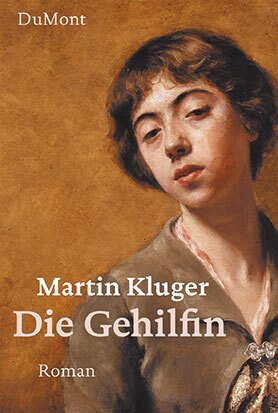Martin Kluger
Die Gehilfin
[The assistant]
- DuMont Buchverlag
- Cologne 2006
- ISBN 3-8321-7845-7
- 318 Pages
- Publisher’s contact details
Martin Kluger
Die Gehilfin
[The assistant]
This book was showcased during the special focus on Arabic I (2004 - 2005).
Sample translations
Review
What turbulent times those must have been. Berlin in the exciting years of rapid industrial expansion, shortly after the establishment of the German empire. A social awakening of a magnitude never known before, an intoxicating economic, and scientific furor. In the women’s wing of the Berlin Charité, a hospital of international reputation even then, where great minds like Rudolf Virchow, Emil von Behring, Paul Ehrlich, and Rudolf Koch worked, a child is born, the mother dies giving birth. The child is Henrietta Mahlow. Her father, Paul, a carpenter who lost his workshop after the death of his wife, now works, between periodic alcoholic excesses, as a male nurse at the Charité. He manages to smuggle his daughter into the daily routine of the hospital. The curious little girl, hungry for knowledge, grows up among reagent jars and dissecting tables, developing an enormous passion for research.
The milieu Martin Kluger (born in Berlin, 1948) chooses for his novel Die Gehilfin (The Assistant) and its fictitious heroine could scarcely be more fascinating. The Charité became the center of the medical world in those heady years of rapid industrial expansion. Rudolf Virchow, Professor of Pathology, and Rudolf Koch, the bacteriologist who was trying to find proof that bacilli are responsible for the outbreak of infectious diseases, tangle with each other. At night corpses are illegally dissected; the young girl is there as a talented assistant when the tuberculosis bacillus is discovered in 1882.
Kluger shows us the Berlin of imperial times, especially its rear courtyards and foul-smelling living-room/kitchens, evoking the damp environment in which tuberculosis rages. “The sky looks like an unmade pink bed in which wild and dirty night lodgers have tossed and turned, newspaper boys wave their damp papers under our noses. Through the open door of a café comes a woman’s deep-throated laughter. Moles, nine-day wonders, and exhausted young things return from their shifts, black with soot. Saliva dribbles from the gaping hole in their faces. They stumble into the nearest bar; the door slams shut, opens, and shuts again.”
Henrietta turns out to be as intelligent as she is ambitious, and yet she is defeated time after time as she comes up against the social barriers set in her path. She would like to study medicine and do her own research, but she is not allowed to. At a large convention Henrietta, dressed as a man, mingles with the participants and decides she will attend the university in this disguise. Kluger follows the ups and downs of Henrietta’s attempts to find a place for herself in this social order, a role that is not limited by her gender but rather corresponds to the young woman’s inclinations and abilities. Spellbound, the reader hurries after her through the hidden hallways of the Charité, past dissecting tables, horror cabinets full of anatomical and biological preparations, suites of laboratories. But in the end the deception is dicovered; Henrietta is ahead of her time and fails in her career as well as her marriage which was purely a case of social climbing.
With well-placed strokes Kluger also succeeds in portraying the great historical researchers who in their scientific curiosity embrace a belief in unstoppable progress even as they steadfastly hold on to the social role models of the era of Emperor Wilhelm II. At first glance Kluger’s story in its historical guise appears to be a novel of social criticism. Its depiction of the adventures of its heroine reminds one of the panoramic social novels of Dickens, Zola, or Balzac. But this work is not just about a female David Copperfield who is thwarted by the insurmountable class-lines and role models of those times. Kluger is also a writer possessed of a most sophisticated narrative technique, having previously demonstrated his abilities in a voluminous 1,000-page zoo novel, Abwesende Tiere (Absent Animals).
He does not simply evoke a costume ball, but plays with changes in perspective, time-dissolves, and even elements of fantasy. At times he enters into the lives of his characters only to withdraw once more to an outsider’s perspective. And, experienced scriptwriter that he is, he achieves thereby an incredibly fast pace. Thus Kluger’s compelling novel itself becomes a microscope under which – among the teeming characters, social types, language milieus, and social conventions – physical perceptions of the most diverse sorts suddenly take shape. An entire world becomes visible, a vanished world in whose feverish forward drive we can recognize ourselves today. “Creatures never seen before, with and without tails, three-handed and one-hundred-handed, multi-eyed and one-eyed beings and some that consist only of an eye, they swarmed together, penetrated one another, fled from one another, they kicked and bit, they lived, they were nasty and multiplied incredibly; they were ugly; they were beautiful.”

The milieu Martin Kluger (born in Berlin, 1948) chooses for his novel Die Gehilfin (The Assistant) and its fictitious heroine could scarcely be more fascinating. The Charité became the center of the medical world in those heady years of rapid industrial expansion. Rudolf Virchow, Professor of Pathology, and Rudolf Koch, the bacteriologist who was trying to find proof that bacilli are responsible for the outbreak of infectious diseases, tangle with each other. At night corpses are illegally dissected; the young girl is there as a talented assistant when the tuberculosis bacillus is discovered in 1882.
Kluger shows us the Berlin of imperial times, especially its rear courtyards and foul-smelling living-room/kitchens, evoking the damp environment in which tuberculosis rages. “The sky looks like an unmade pink bed in which wild and dirty night lodgers have tossed and turned, newspaper boys wave their damp papers under our noses. Through the open door of a café comes a woman’s deep-throated laughter. Moles, nine-day wonders, and exhausted young things return from their shifts, black with soot. Saliva dribbles from the gaping hole in their faces. They stumble into the nearest bar; the door slams shut, opens, and shuts again.”
Henrietta turns out to be as intelligent as she is ambitious, and yet she is defeated time after time as she comes up against the social barriers set in her path. She would like to study medicine and do her own research, but she is not allowed to. At a large convention Henrietta, dressed as a man, mingles with the participants and decides she will attend the university in this disguise. Kluger follows the ups and downs of Henrietta’s attempts to find a place for herself in this social order, a role that is not limited by her gender but rather corresponds to the young woman’s inclinations and abilities. Spellbound, the reader hurries after her through the hidden hallways of the Charité, past dissecting tables, horror cabinets full of anatomical and biological preparations, suites of laboratories. But in the end the deception is dicovered; Henrietta is ahead of her time and fails in her career as well as her marriage which was purely a case of social climbing.
With well-placed strokes Kluger also succeeds in portraying the great historical researchers who in their scientific curiosity embrace a belief in unstoppable progress even as they steadfastly hold on to the social role models of the era of Emperor Wilhelm II. At first glance Kluger’s story in its historical guise appears to be a novel of social criticism. Its depiction of the adventures of its heroine reminds one of the panoramic social novels of Dickens, Zola, or Balzac. But this work is not just about a female David Copperfield who is thwarted by the insurmountable class-lines and role models of those times. Kluger is also a writer possessed of a most sophisticated narrative technique, having previously demonstrated his abilities in a voluminous 1,000-page zoo novel, Abwesende Tiere (Absent Animals).
He does not simply evoke a costume ball, but plays with changes in perspective, time-dissolves, and even elements of fantasy. At times he enters into the lives of his characters only to withdraw once more to an outsider’s perspective. And, experienced scriptwriter that he is, he achieves thereby an incredibly fast pace. Thus Kluger’s compelling novel itself becomes a microscope under which – among the teeming characters, social types, language milieus, and social conventions – physical perceptions of the most diverse sorts suddenly take shape. An entire world becomes visible, a vanished world in whose feverish forward drive we can recognize ourselves today. “Creatures never seen before, with and without tails, three-handed and one-hundred-handed, multi-eyed and one-eyed beings and some that consist only of an eye, they swarmed together, penetrated one another, fled from one another, they kicked and bit, they lived, they were nasty and multiplied incredibly; they were ugly; they were beautiful.”
Translated by Margot Dembo

By Oliver Jahn
